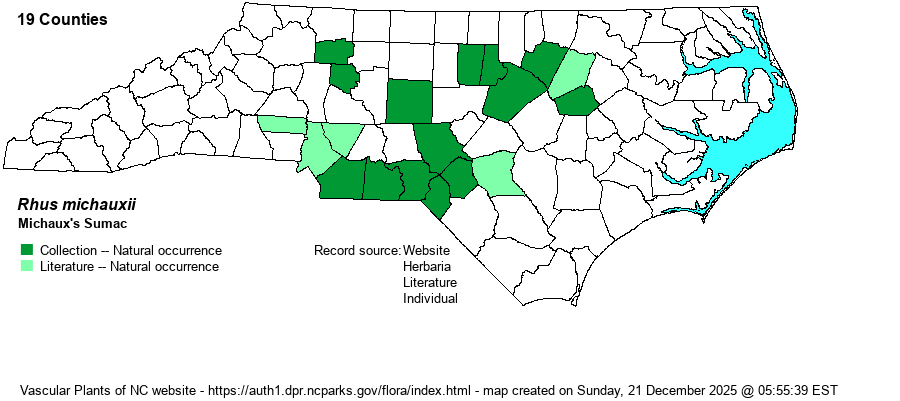| Author | Sargent | |
| Distribution | Very widely scattered over the central and eastern Piedmont and the western Coastal Plain, mainly being found now in the Sandhills. Most of the Piedmont records are in the eastern portions. Not recorded from the Mountains and the eastern and central Coastal Plain.
This is a narrow Southeastern endemic, found only spottily from south-central VA to central GA, and then disjunct to one county in northern FL.
| |
| Abundance | Rare in the Sandhills; very rare in the eastern Piedmont, and extremely rare (now mostly extirpated) outside these areas. This is a State and a Federally Endangered species. | |
| Habitat | The species has several disparate habitats. In the Sandhills, it occurs in loamy sand soils, often in pea swales; these are more diverse sites than are found in deeper sands. In the eastern Piedmont it is found mainly in sandy soil close to (or derived from) granitic flatrocks, but a few sites there and in the central Piedmont occur in dry and thin soil over mafic rock, in circumneutral soil. It is likely that all such sites were previously in fire-prone habitats; the species responds very well to prescribed burns. |
| Phenology | Flowers mainly in June, and fruits mostly in August and September. | |
| Identification | This is a deciduous, dioecious, low shrub that grows mostly below 2 feet tall. As it is rhizomatous, it occurs in colonies that are typically composed only of male plants or female plants, but rarely both together. The entire plant is very tomentose/woolly, including stems and leaves. The pinnate leaves have 9-13 leaflets that are very strongly toothed. Normally, the densely woolly look, which gives the plant a very “soft” and velvety feel when rubbed, would be easy to identify, especially as most plants are barely knee high. Sadly, the common R. glabra may grow in the same places and can hybridize with R. michauxii, further impacting this very rare species. Nonetheless, NCNHP tracks these hybrids as well as pure populations, to preserve the genetic base. It is still possible for you to discover at least a very small population in the Sandhills, but elsewhere in the state new discoveries of sites have occurred only every 5 years, on average. Interestingly, a few new sites were discovered in heavily worked Wake and Durham counties during the past decade or two! | |
| Taxonomic Comments | The original discovery (the type location) by Andre Michaux in 1794 was from what is now western Union County; see the fascinating account by Barden and Matthews (2004).
| |
| Other Common Name(s) | Dwarf Sumac, False Poison Sumac | |
| State Rank | S2 | |
| Global Rank | G2G3 | |
| State Status | E | |
| US Status | LE | |
| USACE-agcp | | |
| USACE-emp | | |

